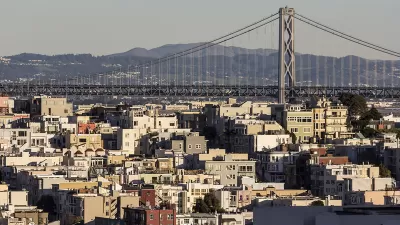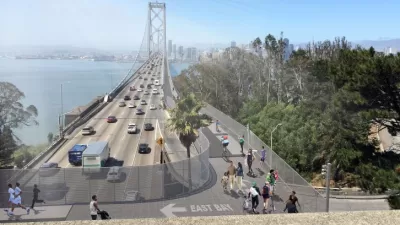With rapidly increasing gaps between costs and funding, the transit systems serving the San Francisco bay area are on an unsustainable path. Egon Terplan offers six solutions to ensure they serve bay area residents long into the future.
With operating costs rising and service falling for the 10% of regional residents who rely on transit to take them back and forth to work every day, and the legions of occasional users, bay area transit is in an unsustainable downward spiral. Terplan summarizes the challenges facing the system thus: "Wages and fringe benefits account for more than three-quarters of the operating and maintenance costs of transit, and the cost of fringe benefits in particular is rising fast. At the same time, budget shortfalls, unpredictable revenues and service cuts are degrading the quality of public transportation."
And the long term impact of a failed transit system would be detrimental to the entire region. "In short, the Bay Area cannot remain economically competitive, nor meet its goals of cutting greenhouse gas emissions, without a transit system that does a better job of getting people where they need to go in a cost-effective and efficient manner."
Interpreting the findings of a recent study called the Transit Sustainability Project (TSP), conducted by the Metropolitan Transportation Commission (MTC), the San Francisco Planning and Urban Research Association (SPUR), of which Egon Terplan is Regional Planning Director, has produced suggestions for overhauling the system based on improvements to six key areas: funding, speeds, fares, competition, information and maps. Each of these suggestions is explained in detail in the article.
Recent news suggests progress is already being made on at least one suggestion, to "[p]roduce a single transit map for the Bay Area and move toward common branding."
FULL STORY: Six Ideas for Saving Bay Area Transit

Planetizen Federal Action Tracker
A weekly monitor of how Trump’s orders and actions are impacting planners and planning in America.

Maui's Vacation Rental Debate Turns Ugly
Verbal attacks, misinformation campaigns and fistfights plague a high-stakes debate to convert thousands of vacation rentals into long-term housing.

Restaurant Patios Were a Pandemic Win — Why Were They so Hard to Keep?
Social distancing requirements and changes in travel patterns prompted cities to pilot new uses for street and sidewalk space. Then it got complicated.

In California Battle of Housing vs. Environment, Housing Just Won
A new state law significantly limits the power of CEQA, an environmental review law that served as a powerful tool for blocking new development.

Boulder Eliminates Parking Minimums Citywide
Officials estimate the cost of building a single underground parking space at up to $100,000.

Orange County, Florida Adopts Largest US “Sprawl Repair” Code
The ‘Orange Code’ seeks to rectify decades of sprawl-inducing, car-oriented development.
Urban Design for Planners 1: Software Tools
This six-course series explores essential urban design concepts using open source software and equips planners with the tools they need to participate fully in the urban design process.
Planning for Universal Design
Learn the tools for implementing Universal Design in planning regulations.
Heyer Gruel & Associates PA
JM Goldson LLC
Custer County Colorado
City of Camden Redevelopment Agency
City of Astoria
Transportation Research & Education Center (TREC) at Portland State University
Jefferson Parish Government
Camden Redevelopment Agency
City of Claremont





























